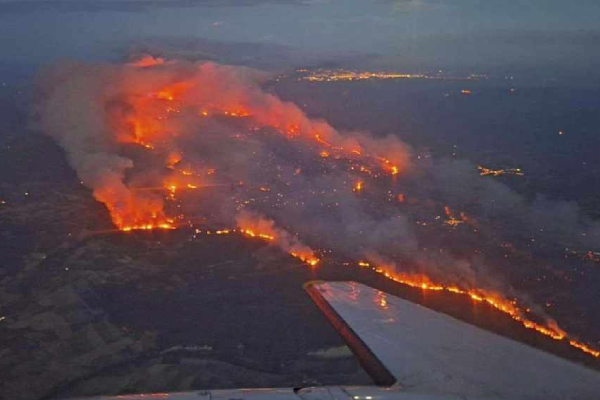France is still battling a wildfire which as grown to the size of Paris in a Mediterranean region bordering Spain.
The wildfire has killed one person and injured several others, according to authorities.
The fire spread across an area larger than Paris on Thursday, prompting the military to intervene.
French Prime Minister François Bayrou described the region as a “disaster on an unprecedented scale”.
The fire, which raced fast across forests and villages, destroyed at least 25 homes or more, forcing inhabitants and tourists to flee.
Many roads are currently closed.
The fire moved incredibly fast, leaving no time to prepare, said Dutch national Renate Koot, who was on holidays in Saint-Laurent-de-la-Cabrerisse with her partner and had to flee.
Interior Minister Bruno Retailleau said the military will reinforce efforts starting from Thursday, with several dozens of soldiers to be deployed.
Jacques Piraux, mayor of the village of Jonquières, said all residents have been evacuated.
Residents and tourists in nearby areas were requested to remain in their homes unless told to evacuate.
Two campgrounds were evacuated as a precaution.
Read Also
Officials and experts warned the wind could change direction, further complicating efforts to fight the wildfire.
Scientists say the Mediterranean region’s hotter, drier summers put it at high risk of wildfires. Once fires start, plentiful dry vegetation and strong winds in the region can cause them to spread rapidly and burn out of control.
According to a climate and agriculture analyst, Serge Zaka, “With climate change, the risk of having wildfires is expected to increase during the summer, but also to extend into the autumn and spring, and to spread toward the southwest, the center, and the north of France.”
The environment ministry said the Aude region has been experiencing a drought this month, with water use restrictions in place.
Lack of rainfall in recent months “played a major role in the spreading of the fire, since the vegetation is very dry,” the statement said.
Europe is the world’s fastest-warming continent, with temperatures increasing at twice the speed of the global average since the 1980s, according to the European Union’s Copernicus Climate Change Service.
Meanwhile, Spain is experiencing a prolonged heatwave since Sunday that was expected to extend into next week, with temperatures reaching 43 degrees Celsius (109.4 degrees Fahrenheit) in some areas.
The high temperatures have helped to fan several wildfires.
Emergency services were still fighting to put out a blaze in the kitesurfing resort of Tarifa in southern Spain on Wednesday that was believed to have been started when a caravan in a campsite caught fire.
Wind gusts of up to 50 km/h and high temperatures meant that certain portions of the previously extinguished fire were restarted, said Antonio Sanz, interior minister for the regional government of Andalusia.
Wildfires in Portugal have burned almost 42,000 hectares this year, the greatest area since 2022 and eight times more than the same period last year.
More than half of the area was damaged in the last two weeks due to high summer temperatures.
In the early hours of Wednesday, firefighters were able to put out a big fire that had been burning since Saturday near Vila Real in the north, where temperatures have reached 40 degrees Celsius this week.





